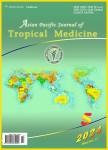Chlamydoconidium-producing Trichophyton tonsurans: Atypical morphological features of strains causing tinea capitis in Ceará, Brazil
作者机构:Specialized Medical Mycology CenterPostgraduate Program in Medical MicrobiologyFederal University of CearáRua Nunes de Melo1315FortalezaBrazil Postgraduate Program in Veterinary SciencesState University of CearáAv.Dr.Silas Munguba1700FortalezaBrazil Department of Tropical MedicineCenter for Health SciencesFederal University of PernambucoRecife-PEBrazil
出 版 物:《Asian Pacific Journal of Tropical Medicine》 (亚太热带医药杂志(英文版))
年 卷 期:2019年第12卷第8期
页 面:380-384页
核心收录:
学科分类:1002[医学-临床医学] 100206[医学-皮肤病与性病学] 10[医学]
基 金:supported by the Conselho Nacional de Desenvolvimento Cientifico e Tecnológico-CNPq Brazil(Grant No.:306976/2017-0)
主 题:Trichophyton tonsurans Chlamydoconidia Dermatophyte Phenotyping
摘 要:Objective: To report atypical morphological features of Trichophyton(T.) tonsurans strains associated with tinea capitis. Methods: Eighty-two T. tonsurans strains isolated in Ceará, Brazil, were analyzed regarding macro and micromorphological features and nutritional patterns. Results: Fifty-two samples presented abundant chlamydoconidia, which were produced in chains. Macroscopically, these strains developed small glabrous colonies that were firmly attached to the surface of the culture medium, with few or no aerial mycelia and intense rusty yellow pigmentation. Seven strains did not grow with stimulus from thiamine. Samples were heterogeneous regarding urease production and none presented in vitro hair perforation. Conclusions: The observation of T. tonsurans strains with distinct phenotypic features indicates the need to revise the taxonomic criteria for routine identification of this dermatophyte.



